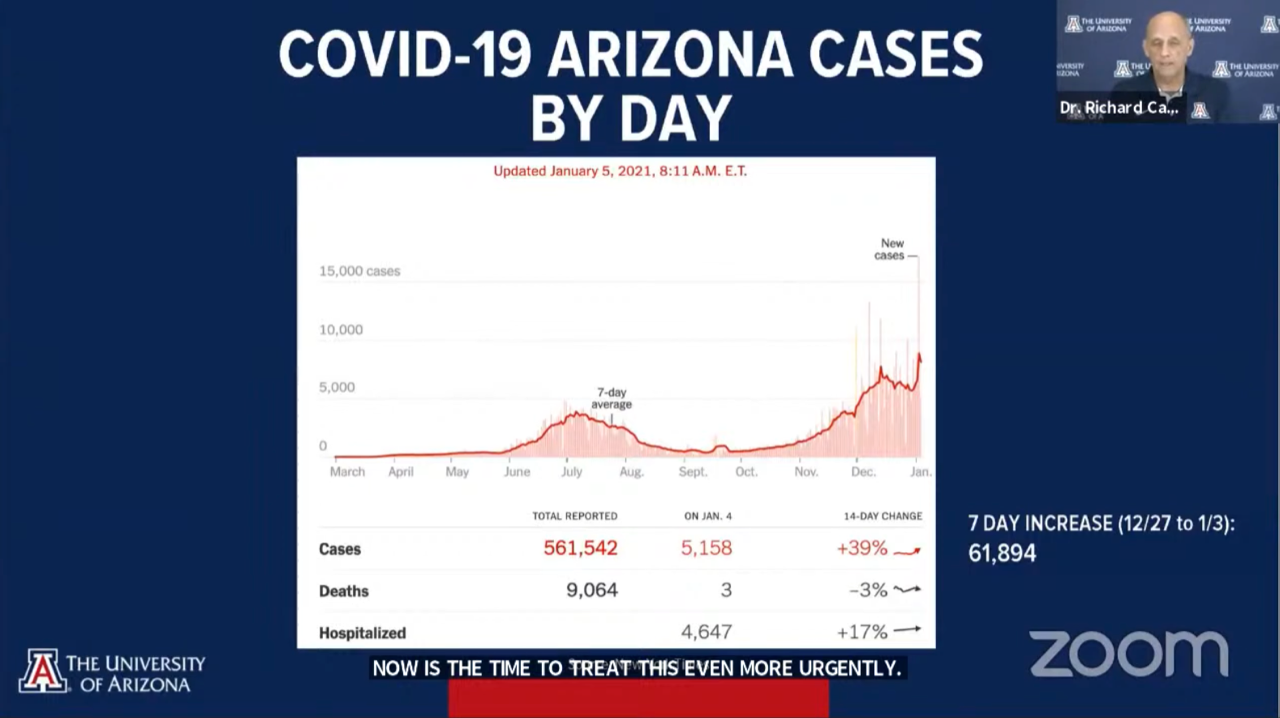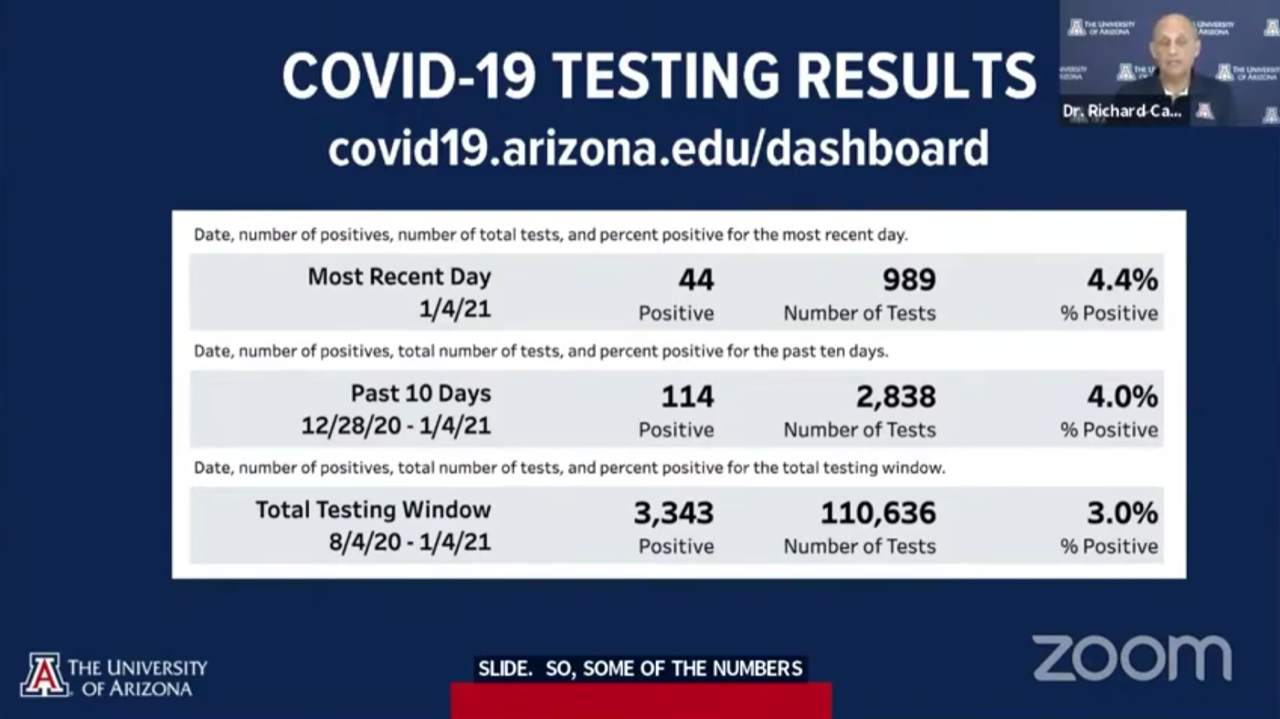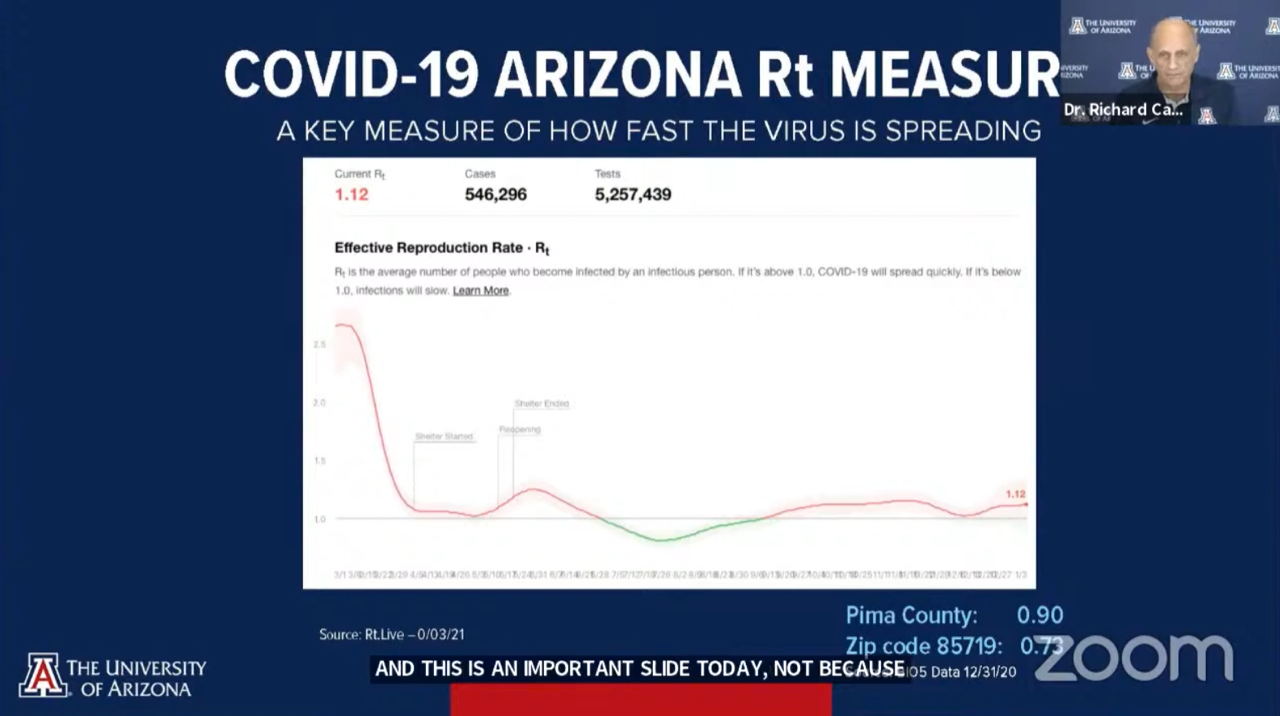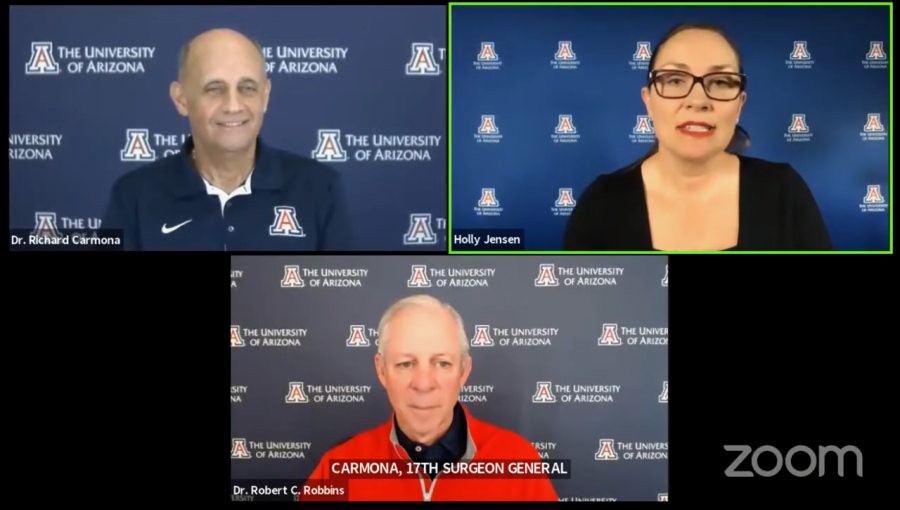The University of Arizona’s COVID-19 reentry task force met Tuesday for the first briefing of the new year. The task force discussed new transmission numbers, new mitigation measures and an increase in state and federal funding.
UA President Dr. Robert C. Robbins began the briefing by announcing that the university would return to Phase 1 of reentry protocol, which permits only “essential” classes of 50 or less to meet in person. The UA will also continue to utilize four modes of instruction for spring semester courses: in-person, flex in-person, live online and online.
Before the briefing this morning, the Coalition for Academic Justice at UArizona sent a letter to the task force advising it to discourage students from returning to campus “prior to the beginning of any in-person classes for which they are registered” and to require students to quarantine for a week after getting tested.
Robbins acknowledged the letter for the first time at today’s briefing, according to the coalition.
RELATED: UA students use Tik Tok trend to thank their teacher
“We did get the letter,” Robbins said. “I would say we’re in agreement. They advocated for what the public health advisory team recommended to us, so we’re all in agreement about how to reenter for the spring semester.”
Robbins estimated that just over 3,900 are enrolled in Phase 1 classes. According to Robbins, just over 3,000 of the students attending in-person classes at the beginning of the spring will be living in on-campus housing, while approximately 710 students will live off-campus.
The president noted that many out-of-state students appear to have chosen to take classes remotely, and also mentioned that the university strongly encourages all employees to work from home if their responsibilities permit it.
“We’re so close,” Robbins said, “but we have to remain vigilant and resilient, and I think that if you can work from home, we want you to do that until we can get through this semester.”
All students will be asked to observe a seven-day self-quarantine following travel from outside of Pima County after receiving a negative test result. Isolation housing will be provided for students who test positive.
“You can go out and get food, obviously,” Robbins said. “You can go to a doctor’s appointment or go to the pharmacy or to the grocery store, but everything else, for the first week, please stay in your place of dwelling.”
Testing for students returning to campus begins Jan. 8.
Regarding new testing compliance initiatives, Robbins mentioned that the university will be emphasizing daily participation in the Wildcat Wellness Check and will be offering rewards to encourage high testing rates. If testing rates fall below recommended level, the university will consider enforcing compliance by suspending access to UA WiFi for students who do not test.
Following the post-winter break testing blitz, the university will debut its new PCR saline gargle test, developed by Michael Worobey, head of the department of ecology and evolutionary biology at the UA. Robbins says this new test is quicker, more accurate and more reliable.
Robbins said that the university now has the means to conduct 3,000 tests per day, almost triple the rate of the fall semester.
“We’ve learned from the fall semester, no question about it,” Robbins said. “With the seven-day return quarantine, mandatory weekly testing and other measures, we’ve put checks in place to detect and respond to any increase in on-campus transmission.”
The president expressed gratitude for the $115 million in Coronavirus Aid, Relief, and Economic Security Act funding delegated by Gov. Doug Ducey to cover COVID-19 related expenditures for Arizona’s three public universities, $46 million of which will go to the UA.
“This funding allows the university to offset expenses from the past nine months, and the new federal COVID-19 relief legislation will cover upcoming expenditures related to the pandemic,” Robbins said. “Together, these two sources of one-time funding have allowed the university to end the employee reduction associated with the furlough and furlough-based salary programs.”
Robbins concluded his segment by expressing optimism that 2021 will bring more good news and reiterated the university’s commitment to collaborate with Pima County and Pima County Public Health Director Dr. Theresa Cullen to mitigate transmission and facilitate the distribution of the vaccine.
“There’s an end in sight,” Robbins said. “We need to keep our work going forward and work together as one group and one community at the university.”
Task force director Dr. Richard Carmona began his segment with an overview of the university’s pandemic experience.
“About a year ago now, we were all trying to figure out what were the scientists talking about with this virus that was starting to move around the world,” Carmona said. “None of us had any experience with it. In fact, this is the first pandemic in over a century that our nation has had to deal with, and the world has had to deal with, and in a relatively short time, we have made monumental advances in science, technology … and it’s reflected here in the university.”
Coronavirus cases at the state level have increased by 39% over the course of the past two weeks. Recorded deaths from COVID-19 are down 3% and hospitalizations are up 17%.

In the university community, 2,838 tests were conducted in the past 10 days yielding 114 positives, a positivity rate of 4.0%.
“These numbers are not to be taken lightly,” Carmona said. “This is not going away. We are not even close yet. We are in the middle of a battle that we all have to come together as one and not be divided by anything. A mask is not a political statement. It is a scientific statement that says, ‘I understand that this virus can kill.’”

Though the rate of transmission of the virus is 1.12 at the state level and 0.90 at the county level, Carmona warned that the data is not yet completely up to date.
“This number represents old data” Carmona said. “As more data is dumped into the system over the next week or so, we’re going to see that number change significantly.”

While the task force is certainly happy to see compliance with public health measures on campus so far, Carmona reemphasized that the UA is part of a larger ecosystem and the university will continue to monitor transmission both on and off campus.
The reentry task force will meet again next Monday morning at 10 a.m.
Follow Kristijan Barnjak on Twitter








